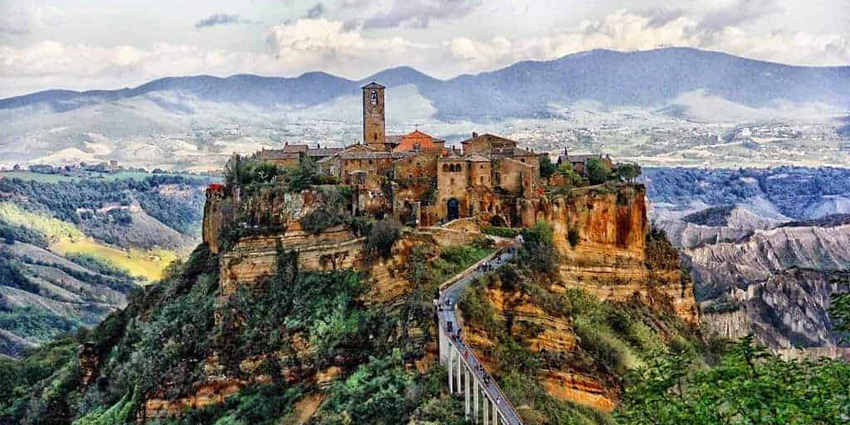
Civita di Bagnoregio: The Timeless Village Suspended Between Sky and Earth
Perched on a fragile hilltop in the heart of northern Lazio, Civita di Bagnoregio is one of Italy’s most enchanting destinations.
Often called “the dying city”, this extraordinary medieval village appears to float above the valleys of the Tuscia region, connected to the modern world only by a slender pedestrian bridge. Its isolation and delicate beauty have turned Civita into a symbol of timeless Italy — a place where history, architecture, and nature blend in perfect harmony.
A Journey Through History and Legend
Founded by the Etruscans over two thousand years ago, Civita di Bagnoregio has witnessed centuries of transformation. The village’s strategic position once made it a thriving center for trade and defense, but erosion of the volcanic rock on which it stands gradually isolated it from the surrounding landscape. Today, this fragility gives Civita its unique charm: a village seemingly frozen in time, where the echoes of the past still resonate through its narrow streets and stone walls.
The Porta Santa Maria, the only gateway into the village, welcomes visitors with an atmosphere that immediately evokes another era. Passing through its arch means stepping into a world of silence and simplicity, where every detail — from the carved doorways to the small flowered balconies — tells a story of resilience and beauty.
Architecture and Atmosphere of a Medieval Gem
Civita di Bagnoregio is a masterpiece of medieval architecture. Its narrow lanes are lined with houses built from golden tufa stone, glowing warmly under the sunlight. The layout of the village has remained almost unchanged for centuries, preserving its original charm and intimate proportions. At the heart of Civita lies Piazza San Donato, a small square that serves as the social and spiritual center of the community. The Church of San Donato, with its Romanesque façade and simple interior, stands as a reminder of the village’s enduring faith and cultural continuity.
The absence of cars and modern noise enhances the sense of serenity. Time seems to slow down among these ancient walls, where the rhythm of daily life follows the seasons and the passing light that paints the landscape in endless shades of gold, green, and ochre.
The Landscape of the Calanchi: A Natural Wonder
The surrounding landscape is as striking as the village itself. Civita rises above the Calanchi Valley, a network of deep clay gullies sculpted by centuries of wind and rain. This ever-changing terrain, shaped by geological erosion, creates a surreal panorama that contrasts the stability of the built village with the dynamic forces of nature.
From the bridge leading to Civita, the view stretches across a landscape of rare beauty — a mosaic of cultivated fields, wild vegetation, and dramatic cliffs. At sunrise and sunset, the scene becomes almost ethereal, as mist and light blend to create a dreamlike vision of the “city in the sky.”
A Cultural and Environmental Treasure
Civita di Bagnoregio represents more than just a beautiful village; it embodies the harmony between human creation and natural landscape. Efforts to preserve the site have increased over recent decades, with recognition from UNESCO as a candidate for World Heritage status. The village’s fragile environment has inspired studies in geology, architecture, and sustainable tourism, making Civita not only a destination of beauty but also of learning and reflection.
Visitors from around the world are drawn by its authenticity — an authenticity that resists time and modernity. Every stone, every view, and every silent alley reflects the delicate balance between permanence and impermanence, between the enduring spirit of humanity and the power of nature.
The Essence of Timeless Italy
Civita di Bagnoregio is more than a destination; it is an experience of stillness and connection. In this suspended world, travelers can rediscover the essence of the Italian countryside — the art of living slowly, the respect for heritage, and the quiet dialogue between past and present. Whether wrapped in morning mist or bathed in golden afternoon light, Civita remains a rare example of how beauty can endure through fragility, inviting contemplation rather than consumption.